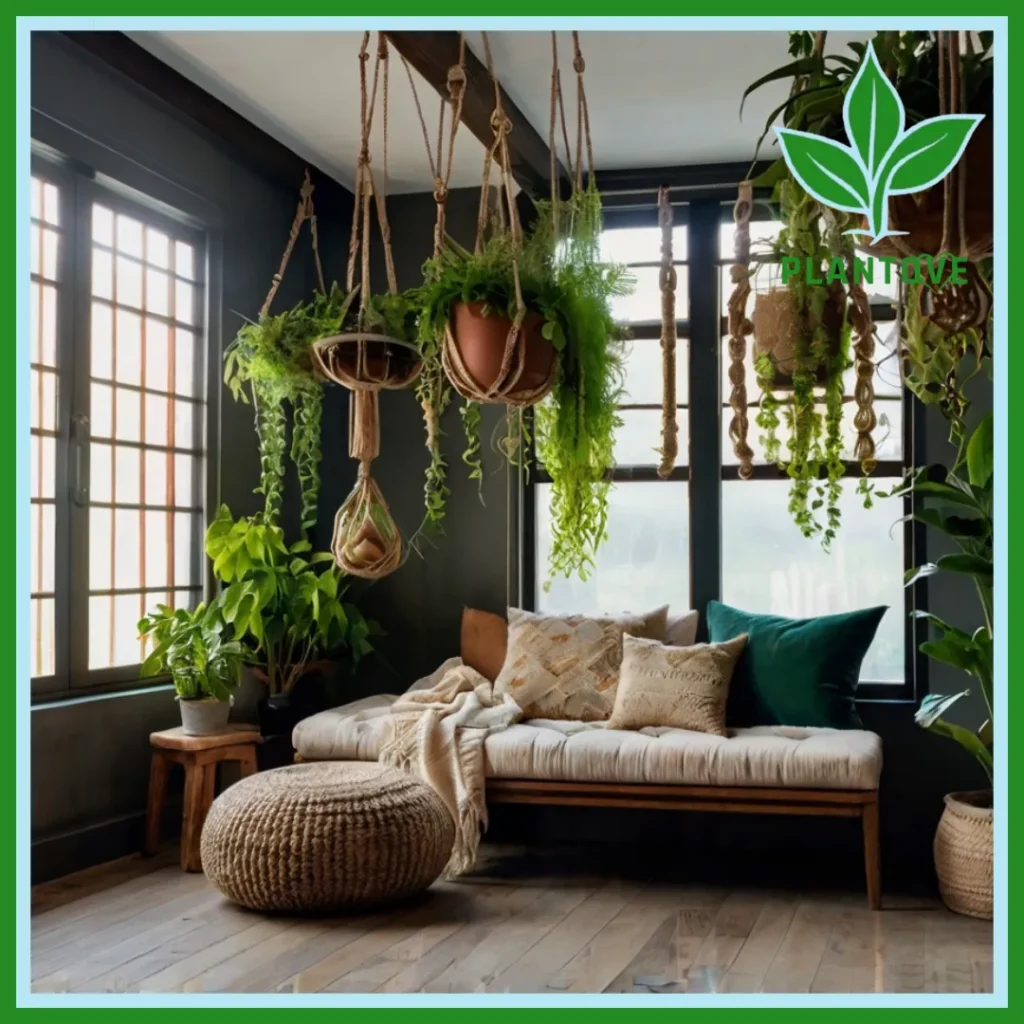Hanging plants have garnered immense popularity in the realm of indoor gardening, and it’s easy to see why. They bring a touch of nature indoors, provide a fresh and lively ambiance, and are ideal for both small and large spaces. Their versatility in complementing various decor styles and their ability to thrive in different conditions make them a favorite among plant enthusiasts. This comprehensive guide will delve into the types of hanging plants, their benefits, care tips, and creative ways to style them, ensuring you can make the most of these verdant beauties.
Choosing the Right Hanging Plants
Selecting the right hanging plants involves understanding their specific needs and how they will fit into your indoor environment. Here’s a closer look at some popular options:
Trailing Vines
- Pothos (Epipremnum aureum)
- Light Requirements: Pothos are incredibly adaptable and thrive in low to bright, indirect light. They are perfect for rooms with varying light conditions.
- Care Needs: They are low-maintenance and can tolerate periods of neglect. Water when the top inch of soil is dry, and they’ll reward you with lush, trailing vines.
- English Ivy (Hedera helix)
- Light Requirements: Prefers bright, indirect light but can tolerate lower light conditions.
- Care Needs: Keep the soil consistently moist, and maintain higher humidity levels to prevent issues like leaf drop. Regular misting can help.
- String of Pearls (Senecio rowleyanus)
- Light Requirements: Requires bright, indirect light to thrive.
- Care Needs: Water when the soil is completely dry. Ensure good drainage as overwatering can lead to root rot.
Ferns
- Boston Fern (Nephrolepis exaltata)
- Light Requirements: Adaptable to low to bright, indirect light.
- Care Needs: High humidity is crucial for Boston ferns. Keep the soil moist but not soggy, and consider using a pebble tray to increase humidity around the plant.
- Bird’s Nest Fern (Asplenium nidus)
- Light Requirements: Prefers low to moderate, indirect light.
- Care Needs: This fern appreciates humidity, so ensure the soil surface remains slightly dry between waterings. It’s best to avoid letting the plant sit in water.
Succulents
- Burro’s Tail (Sedum morganianum)
- Light Requirements: Thrives in bright, indirect light.
- Care Needs: Water sparingly, allowing the soil to dry out between waterings. This plant requires excellent drainage to prevent root rot.
- String of Bananas (Senecio radicans)
- Light Requirements: Enjoys bright, indirect light.
- Care Needs: Like other succulents, it requires well-draining soil and infrequent watering. Ensure the pot has drainage holes to keep the roots healthy.
Benefits of Hanging Plants
Hanging plants offer a multitude of benefits that go beyond their visual appeal:
- Improving Indoor Air Quality: Many hanging plants act as natural air purifiers. They help filter out common indoor pollutants such as formaldehyde, benzene, and trichloroethylene, making the air cleaner and healthier to breathe.
- Enhancing Decor: The presence of hanging plants adds a natural element to your decor. Their cascading foliage creates a striking visual contrast against walls and ceilings, adding depth and interest to any room.
- Creating a Calming Environment: Plants are known for their stress-relieving properties. The act of caring for plants and their presence in your space can lower stress levels, promote relaxation, and improve overall mental well-being.
- Maximizing Space: Hanging plants are perfect for small spaces where floor area is limited. They utilize vertical space effectively, allowing you to create a green oasis without sacrificing valuable floor space.
How to Care for Hanging Plants

Proper care is essential to ensure your hanging plants thrive. Follow these guidelines for optimal results:
Watering
- Frequency: Different plants have varying watering needs. For example, pothos and English ivy need more frequent watering compared to succulents like Burro’s Tail. Check the top inch of soil to determine when to water.
- Method: Water evenly and thoroughly, ensuring that the entire root system receives moisture. Avoid letting plants sit in water, as this can lead to root rot.
Fertilizing
- Type: Use a balanced, water-soluble fertilizer for most hanging plants. Succulents benefit from a diluted cactus fertilizer.
- Frequency: Fertilize during the growing season (spring and summer) every 4-6 weeks. Reduce or halt fertilization in the fall and winter, as plants generally grow more slowly during these times.
Pruning
- Purpose: Pruning helps to maintain the plant’s shape and encourage new growth. Trim back leggy or overgrown stems to keep the plant looking full and vibrant.
- Method: Use clean, sharp scissors or pruning shears to make precise cuts. Remove dead or yellowing leaves to improve the plant’s overall health.
Handling Common Pests
- Pests: Common indoor plant pests include spider mites, aphids, and mealybugs. Regularly inspect your plants for signs of pests such as discolored leaves or webbing.
- Treatment: Use insecticidal soap or neem oil to treat minor infestations. For more severe cases, consider systemic insecticides or consult a professional.
Styling Your Hanging Plants
Creative styling can elevate your indoor garden and enhance your home’s decor. Here are some ideas:
Grouping Plants
- Visual Impact: Grouping hanging plants together can create a lush, green focal point. Varying the types and heights of plants can add dimension and visual interest.
- Placement: Hang plants at different levels to create a cascading effect. This can be achieved by using multiple hooks or plant hangers at varying heights.
Using Macramé Plant Hangers
- Aesthetic Appeal: Macramé plant hangers add a bohemian touch to your decor. They come in various colors, patterns, and styles to match your home’s theme.
- DIY: Creating your own macramé hangers is a rewarding project. There are numerous online tutorials available to guide you through the process.
Incorporating Planters
- Upcycled Containers: Repurpose old containers like teacups, baskets, or jars for a unique display. Ensure that these containers have proper drainage holes to keep your plants healthy.
- Decorative Pots: Choose decorative pots that complement your interior design. Options include ceramic, terracotta, or woven baskets.
DIY Projects
Engaging in DIY projects for your hanging plants can be a fun and creative way to personalize your indoor garden. Here are a couple of ideas:
Macramé Plant Hangers
- Materials: Gather macramé cord, a ring or hook, and scissors.
- Instructions: Follow a basic macramé pattern to create a plant hanger. You can find numerous tutorials online, or even take a local craft class.
Upcycled Plant Containers
- Materials: Old containers, paint, and brushes.
- Instructions: Clean and paint old containers to give them a fresh look. Ensure you add drainage holes if the container doesn’t already have them. This allows for proper water flow and prevents root rot.
Troubleshooting
Even with the best care, issues may arise with your hanging plants. Here’s how to address common problems:
Yellowing Leaves
- Causes: Yellowing leaves can result from overwatering, nutrient deficiencies, or insufficient light.
- Solution: Adjust your watering routine, ensure the plant is getting the right amount of light, and check for pests. If necessary, provide a balanced fertilizer to address nutrient deficiencies.
Leggy Growth
- Causes: Insufficient light or lack of pruning can cause plants to become leggy.
- Solution: Move the plant to a brighter location or increase light exposure. Regularly prune back leggy stems to encourage fuller growth.
Root Rot
- Causes: Overwatering or poor drainage can lead to root rot.
- Solution: Allow the soil to dry out between waterings and ensure your pots have drainage holes. If root rot is severe, repot the plant in fresh, well-draining soil.
Hanging plants offer a multitude of benefits, from improving indoor air quality to enhancing home decor. With the right care and creative styling, you can turn your indoor space into a lush, green retreat. Whether you’re looking to add a touch of nature to your home or create a vibrant indoor garden, hanging plants provide a versatile and rewarding option. Embrace the beauty and benefits of hanging plants and start transforming your living space today.

